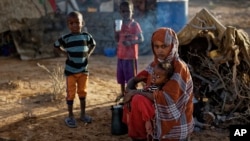Ahmed Haji turns from his visibly dehydrated animals and whispers: "I am lost."
Trying to flee the worsening drought, he trekked thousands of kilometers with a herd that once numbered 1,200. But hundreds perished during the arduous trip to Puntland, in northern Somalia, in search of greener pasture.
The land here dried up not long after he arrived, leaving his animals weak from hunger and thirst. "They are now dying one by one," the 30-year-old said, shading his face from the scorching sun. His goats drank water from a plastic barrel and picked dry leaves from plants nearby.
"I don't even think these remaining ones will survive in the next two months," Haji said. He left his wife and five children behind on his eight-day trek, fearing they wouldn't survive. Now he wonders about himself.
Largest humanitarian crisis since World War II
Somalia has declared this drought a national disaster, part of what the United Nations calls the largest humanitarian crisis since the world body was founded in 1945.
An estimated 6 million people in this Horn of Africa nation, or about half the population, need aid amid warnings of a full-blown famine. Two consecutive seasons of poor rainfall, longer in some areas, have caused large-scale crop failures, the U.N. humanitarian agency says.
It is not clear how many people, or animals, have died so far.
Animals are central to many in Somalia. The United Nations says more than half the population is engaged in the livestock industry. The drought threatens their main sources of nutrition and survival.
Many wells have dried up, forcing herders to risk long treks to remote areas. Water prices have spiked, with a single water tanker now going for $150.
The hot wind blows across the vast, barren land and carcasses of animals.
"The sad reality of the drought this severe, this long, this enduring is we're starting to see these massive livestock deaths, livestock losses. Fifty, 60, 70 percent of livestock herds dying, which is an enormous hit for these pastoral families," said Richard Trenchard, the U.N. Food and Agriculture Organization representative in Somalia.
The mass animal deaths, from hunger and thirst as well as disease, have caused herders to lose "just about everything," Trenchard said, standing beside the carcass of a camel.
Rain could add to catastrophe
Even though rains are expected in mid-April, there are fears that effects of a heavy downpour could kill already weakened animals.
With their livestock gone, herders are ending up in camps with shortages of food, medicine and safe drinking water.
"Our journey here was so rough. There was no transport or water. We left behind everything. We are here now and we don't have any proper shelter or transport," said Dahiya Ahmed, a 48-year-old mother of eight at a camp in Qardho town.
She once herded 200 goats but now has just six. "The few of them that are still alive are too weak and cannot provide us with milk and meat," she said. "They are just still alive but cannot benefit us at all."
With the rise of disease-related deaths among the remaining animals, the United Nations is planning a major animal vaccination intervention. Some herders are being given basic training on vaccinating their animals and giving oral medications on their own.
"Hungry animals, starving animals are very vulnerable, very prone to disease," Trenchard said.
Around two million animals are targeted for treatment against parasites, infectious disease and wounds, said Khalid Saeed, the FAO livestock sector coordinator, as he gave medicine to sick and weakened animals.
Somalia is part of a massive $4 billion aid appeal launched last month for four nations suffering from conflict and hunger. The others are Nigeria, Yemen and South Sudan, where famine already has been declared in two counties.










